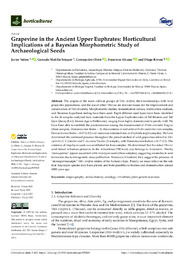Título :
Grapevine in the Ancient Upper Euphrates: Horticultural Implications of a Bayesian Morphometric Study of
Archaeological Seeds |
Autor :
Valera, Javier
Matilla-Seiquer, Gonzalo
Obon, Concepcion 
Alcaraz, Francisco
Rivera, Diego |
Editor :
MDPI |
Departamento:
Departamentos de la UMH::Biología Aplicada |
Fecha de publicación:
2023 |
URI :
https://hdl.handle.net/11000/38316 |
Resumen :
The origins of the main cultivar groups of Vitis vinifera, their relationships with wild
grapevine populations, and the use of other Vitaceae are relevant issues for the improvement and
conservation of Vitis diversity. Morphometric studies, domestication indices, multivariate analyses,
and Bayesian hypothesis testing have been used. Eight different seed types have been identified
in the 24 samples analyzed from materials from the Upper Euphrates sites of Tell Khâmis and Tell
Qara Quzaq (Early Bronze Age to Hellenistic), ranging from highly domesticated to purely wild. We
have been able to establish the predominance among the domesticated of Proles orientalis Negrul
(three samples, Domestication Index = 1), the existence of and extinct Proles euphratica (six samples,
Domestication Index = 0.67–0.83) and numerous intermediates and hybrids (eight samples). We have
determined the continued presence throughout the period studied of wild grapevines related to Vitis
sylvestris C.C.Gmelin and V. caucasica Vavilov (5 samples, with Domestication Indices = 0.17–0.5). The
existence of Ampelopsis seeds was established for three samples. We determined that the oldest Vitaceae
seed linked to human presence, in the Acheulense (780 myr), also belongs to Ampelopsis. Finally,
“stenosperms” appear associated with Ampelopsis seeds (three samples), suggesting anomalies in seed
formation due to intergeneric cross-pollination. Moreover, if isolated, they suggest the presence of
“stenospermocarpic” Vitis vinifera raisins of the Sultanina type. Finally, we must reflect on the role
that Ampelopsis species may have played and their possible cultivation and domestication almost
4000 years ago.
|
Palabras clave/Materias:
ampelography
archaeobotany
oenology
viticulture
plant genetic resources |
Tipo de documento :
info:eu-repo/semantics/article |
Derechos de acceso:
info:eu-repo/semantics/openAccess |
DOI :
https://doi.org/10.3390/horticulturae9070803 |
Publicado en:
Horticulturae 2023, 9, 803. |
Aparece en las colecciones:
Artículos - Biología Aplicada
|
 La licencia se describe como: Atribución-NonComercial-NoDerivada 4.0 Internacional.
La licencia se describe como: Atribución-NonComercial-NoDerivada 4.0 Internacional.
.png)
